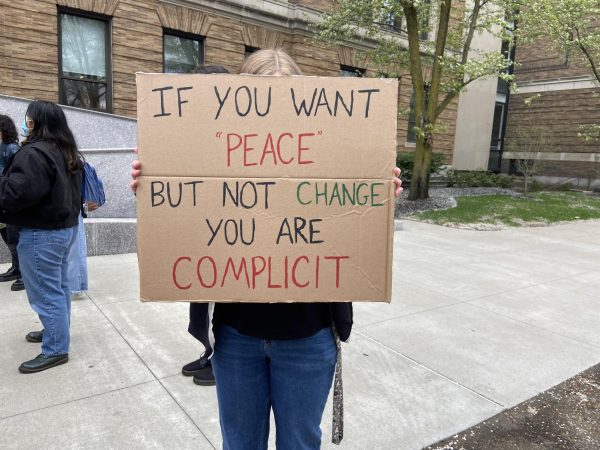What Makes Us Human

Source: verily.com
May 6, 2019
It was June and sweltering hot, the air conditioning provided much needed relief. Our orientation leader surveyed the room before announcing, “let’s do an icebreaker so we can get to know each other. Please say your name, where you’re from and a fun fact.”
Ice breakers, everybody groaned.
I registered the annoyance my peers felt, but it was drowned out by other emotions in my head.
You shouldn’t be here. The voice of self-awareness insisted.
I need to be, I must start college off on the right foot, determination responded.
How can you make a good impression like this? You’re a mess.
I have to try, act natural, happy. It’s what is expected.
All around me, girls casually introduced themselves. I didn’t catch their names, consumed by an overpowering mixture of anxiety, fear, sadness, and emptiness. I’d hardly mustered the strength to stop sobbing and sit in this room. A few minutes before, I’d smiled and assured my mother I would be okay. While I might have fooled those around me, I hadn’t fooled her. Was anyone else feeling how I was?
Then it was my turn to talk, I could have spoken up and made my feelings known, “I’m Katie, from Rhode Island and I just wanted everyone to know I don’t feel so well today, very nervous and uneasy. I might appear standoffish but I’m not usually like that. When I feel how I do right now, socializing is challenging, but I really want to be here with you. Thanks for understanding.”
Instead I did my best to smile. “Hi my name is Katie. I’m from Barrington, Rhode Island, a suburb of Providence. My fun fact is, I’ve got a pet frog who is seven years old.”
Today, when I reflect on the disaster that summer orientation was, I find two flaws. First, I refused to listen to myself, and make the hard decision to go home. Second, my failure to make my struggles known stemmed from fear of the judgments of others.
Both problems I encountered arise from society’s aversion to discussion of emotions. From a young age we are taught that emotions are “personal.” While in reality, feelings are anything but “personal,” what we feel and when we feel it affects every part of our daily interactions. When employees struggle to control their emotions, their work performance is negatively impacted. Marriages and families suffer when members suffer in silence. If others know your struggles they can provide support and understanding.
Why am I and others afraid to reach out? Because culture portrays emotion negatively. When men express their feelings they are weak, and “unmanly”. Emotional women are pegged as high maintenance, volatile, and moody.
Emotional intelligence is the key to breaking emotional stereotypes. The Oxford Dictionary of Psychology defines emotional intelligence as “the capability of individuals to recognize their own emotions and those of others, discern between different feelings and label them appropriately, use emotional information to guide thinking and behavior, and manage and/or adjust emotions to adapt to environments or achieve one’s goals.”
In an essence, emotionally intelligent individuals are:
- Aware of their emotions and those around them.
- Aware of how their thoughts and actions affect emotions.
- Able to modify their actions and thoughts to positively regulate emotions.
The power of emotional intelligence is that it can be learned, just like math or spelling. With instruction and practice people can learn to healthily deal with their feelings. Children should be encouraged to express their feelings because it will reduce their aversion to emotion and develop emotional intelligence in the process. Teaching youth is the most effective way to break the cycle of emotional stereotypes.
When I feel overwhelmed I have learned to quickly calm myself with coping strategies, exercises that dissipate strong emotions. There’s a tightness in my chest for no apparent reason. Why this? Why now? Cold air flows in and out lungs and I struggle for control. As I walk, I describe my surroundings whispering softly into the open air. My breath creates small puffs of smoke as I force the words out from trembling lips.
“There are no boats moored in the harbor.”
“Sheets of ice are washed up on the bank, some white, others clear almost translucent. They are different sizes.” Deep breaths, I tell myself, it will be ok.
“I can feel the cold through my pants, it makes my thighs sting.”
“Silver jeep is at the stop sign. A BMW stopped behind the Jeep, it is blue.” My words slip out less strained, the cadence still broken, split apart by deep breaths.
A man approaches, walking a fluffy white dog.
Stop talking he’ll hear you! The powerful voice of social expectation rings in my ears. I fall silent.
That’s irrational; you’re talking so quietly he won’t hear. And besides, who cares. You aren’t doing this for him; you’re doing it for you. Self-awareness insists.
Who wants to risk becoming the neighborhood crazy.
You’ll never see him again.
It isn’t long until he’s out of earshot. Once certain he can’t hear, I begin again.
“A flock of geese is floating on the water. Four ducks swim ahead of them.”
“The grass is frozen and matted, brown with a few spots green. There is a silver ribbon on the ground” Which I bend down to pick up. Collecting the trash is grounding, methodical, calming almost.
In a voice almost normal, smooth voice I continue collecting, “an orange bottle cap, from Gatorade. An empty pack of light bulbs.”
Handful of trash collected, the tightness subsides, and I am relieved. Panic attack avoided using Cognitive Behavioral Therapy, or CBT coping skills.
I haven’t always been in tune with my emotions; in fact I ignored them until they forcefully took over my life. After a lot of instruction and even more practice I’ve learned to take hold of my mind using CBT. The main goal of CBT is to teach individuals how to control difficult and overwhelming emotional reactions with coping skills. Even at sixteen it was hard for me to overlook the ingrained societal aversion to mental health treatment and accept that my emotions were out of control. Looking back, I can pinpoint the stressors that elevated my distress: the desire for perfect grades, college applications, falling out with friends and social media.
The truth is, the increased distress I experienced is not the outlier, but the trend. Stress levels of Americans are on the rise and people of all ages adults, teens and children are feeling negative effects. Teenagers in 2019 are the first generation in over 100 years to experience more stress than their parents (Brackett).
I was an anxious child, I hated going to school. In the summer months I wouldn’t go outside because I was afraid to see my classmates. Journal of Developmental and Behavioral Pediatrics estimates that 2 million children have diagnosable anxiety disorders. Afflicted children display a wide range of symptoms anger, tantrums, clinginess, fear going to school or out in public, chronic stomach and headaches. It is hard for schools to recognize students with childhood anxiety disorder; many times symptoms are written off as behavioral issues and the child is left without care. Perhaps because of my personal connection to the topic, I am very hard on the school system. Many schools have social workers and support systems for students with diagnosed disorders. In health class students are taught about the symptoms of depression and how to ask for help. Even with all this support, teachers are undereducated on childhood mental health issues. If schools made emotional education a priority for staff, afflicted students would get the help they needed sooner. Early intervention treatment has the greatest potential to help students because it is most effective treatment for anxiety (Hurley).
Mental health issues become widespread as children grow older. American teenagers have one of the highest rates of alcohol and drug abuse and the highest suicide rate in the world (Brackett). From my experiences I’ve come to realize that the teenage brain is young, impulsive and inexperienced. As a result, when under pressure, teens are unaware of how to healthfully mediate distress. Most often they turn to escapism, and this almost always involves substance abuse. It is easy to understand where teens come from, instant gratification is always preferable to grinding forward, working hard to cope. But in the end, substance use inflicts more distress than it avoids, because rather than reducing distress it distract from it. Escaping feelings is impossible and high levels of mismanaged stress can lead to suicide.
The question I wrestle with, is how we can prevent this? People don’t need to suffer unnecessarily afraid to seek treatment. There should be no shame in acknowledging your mental health. Sadly, the term mental health carries many negative connotations. At its core, mental health is really about managing emotions. Emotions are a necessary part of living a happy and healthy life. Emotions make life worth living. Healthy emotions are as vital to life as breathing lungs or a beating heart. Organs keep us alive, but more importantly emotions tell us we are alive, they make us human. For that reason we should not call it mental health but just health.

















